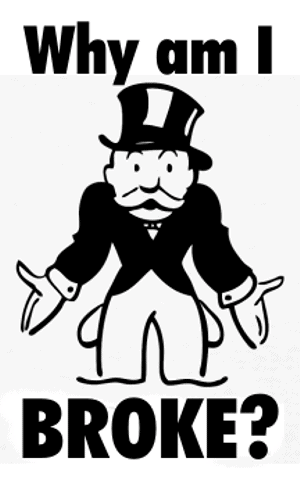
So we’ve got our baby emergency fund started. Now we’re onto what is the longest baby step for many of us — Baby Step 2 — the Debt Snowball.
But how exactly do we do the debt snowball? And why?
Debts First
Most millionaires agree the best way to build wealth from scratch is to become debt free. Why? Because many broke people have high balances on credit cards. And these credit cards have the highest interest rates!
Yet there is still the urge of many would-be millionaires to “invest while the investing is good.”
The stock market was up for a long while. Time to buy, buy, buy!
Then came the COVID-19 shut-down… oh, crap. Sell all our earnings at the bottom due to fear.
Fast forward 6 months, the market is back up! Time to buy, buy buy!
But wait… now the market looks like it may be going down again. Let’s wait until we can’t stand it any longer, then sell, sell, sell.
Out of fear, many of us do exactly the opposite of buy low, sell high. We buy high, because it feels safe…
Then the market corrects, and we become fearful and sell low.
We do this all while paying minimum payments on an 18%, 24%, even 32% credit cards!
Buy high, sell low is a losing proposition. And if we’re straddled with high-interest credit cards to boot… we may as well plan on handing out smiley-face stickers at China Mart when we’re 80.
Losing money in the stock market without paying off debts is a recipe for disaster!
That’s why we payoff credit cards first. When we’re debt-free, we have a lot less stress when our investments fluctuate. And we all know investments fluctuate!
Anatomy of the debt snowball
Do you see why we need to be debt-free before we start investing? When we have no debt, it’s easier to hang on for that rollercoaster ride known as the stock market.
Convinced yet? If not, stop reading. Maybe you’ll put a smily face on my grandkid one day at China Mart.
TO START a debt snowball, we need to list all our debts, except our mortgage (if we have one). Then sort them from lowest to highest without regard for the interest rates. (They’re all high!)
Maintain minimum payments on all debts but the lowest balance. Squeeze as much as possible out of our budget to put on the lowest balance. (This amount may change from month to month.)
Why?
The smallest balance will be paid off the fastest. This gives a us a psychological edge when it comes to starting our debt snowball
After the lowest balance debt is paid-off FOREVER, we roll the amount we were paying onto the next smallest debt. When the second smallest debt is gone, roll the total of the first two onto the third lowest, and so on.
Hence, the debt “snowball.” By the time we get to the highest balance, it will already be smaller from months of minimum payments. But the snowball is now big enough to make the final debt seem as short in duration as the first debt. With laser beam focus, we eliminate one debt at a time.
But the hardest part about the debt snowball is not setting up the spreadsheet… it’s convincing ourselves to forget TOTALLY about investing until we’re debt-free.
Once we’re debt-free, then we look at setting up our retirement savings and appropriate asset allocation.
Reach out if you need help setting up YOUR debt snowball! I’ve done it, and I can tell you having a plan is a huge de-stressor. We could even do a virtual meeting via Zoom!